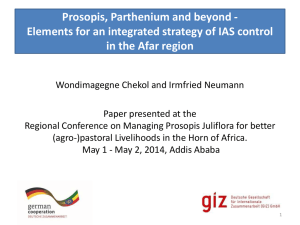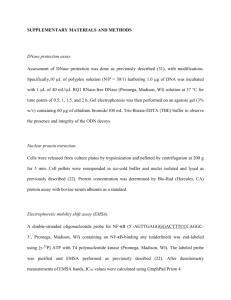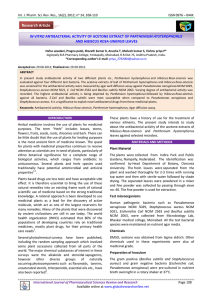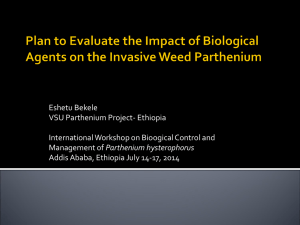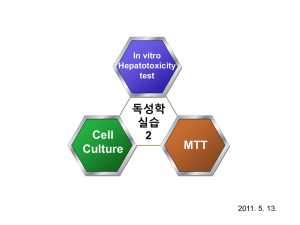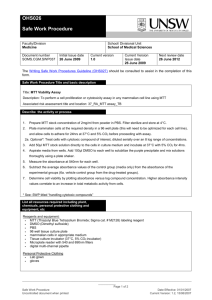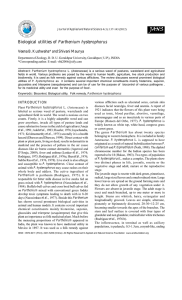Document 13308152
advertisement
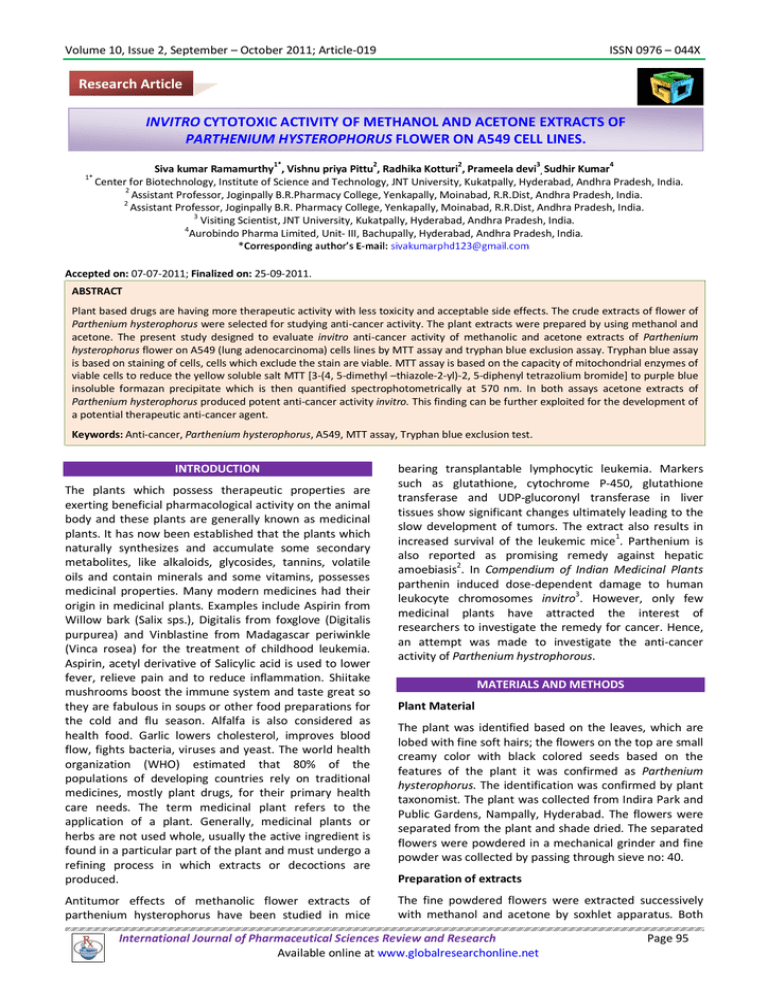
Volume 10, Issue 2, September – October 2011; Article-019 ISSN 0976 – 044X Research Article INVITRO CYTOTOXIC ACTIVITY OF METHANOL AND ACETONE EXTRACTS OF PARTHENIUM HYSTEROPHORUS FLOWER ON A549 CELL LINES. 1* 1* 2 2 3 4 Siva kumar Ramamurthy , Vishnu priya Pittu , Radhika Kotturi , Prameela devi , Sudhir Kumar Center for Biotechnology, Institute of Science and Technology, JNT University, Kukatpally, Hyderabad, Andhra Pradesh, India. 2 Assistant Professor, Joginpally B.R.Pharmacy College, Yenkapally, Moinabad, R.R.Dist, Andhra Pradesh, India. 2 Assistant Professor, Joginpally B.R. Pharmacy College, Yenkapally, Moinabad, R.R.Dist, Andhra Pradesh, India. 3 Visiting Scientist, JNT University, Kukatpally, Hyderabad, Andhra Pradesh, India. 4 Aurobindo Pharma Limited, Unit- III, Bachupally, Hyderabad, Andhra Pradesh, India. Accepted on: 07-07-2011; Finalized on: 25-09-2011. ABSTRACT Plant based drugs are having more therapeutic activity with less toxicity and acceptable side effects. The crude extracts of flower of Parthenium hysterophorus were selected for studying anti-cancer activity. The plant extracts were prepared by using methanol and acetone. The present study designed to evaluate invitro anti-cancer activity of methanolic and acetone extracts of Parthenium hysterophorus flower on A549 (lung adenocarcinoma) cells lines by MTT assay and tryphan blue exclusion assay. Tryphan blue assay is based on staining of cells, cells which exclude the stain are viable. MTT assay is based on the capacity of mitochondrial enzymes of viable cells to reduce the yellow soluble salt MTT [3-(4, 5-dimethyl –thiazole-2-yl)-2, 5-diphenyl tetrazolium bromide] to purple blue insoluble formazan precipitate which is then quantified spectrophotometrically at 570 nm. In both assays acetone extracts of Parthenium hysterophorus produced potent anti-cancer activity invitro. This finding can be further exploited for the development of a potential therapeutic anti-cancer agent. Keywords: Anti-cancer, Parthenium hysterophorus, A549, MTT assay, Tryphan blue exclusion test. INTRODUCTION The plants which possess therapeutic properties are exerting beneficial pharmacological activity on the animal body and these plants are generally known as medicinal plants. It has now been established that the plants which naturally synthesizes and accumulate some secondary metabolites, like alkaloids, glycosides, tannins, volatile oils and contain minerals and some vitamins, possesses medicinal properties. Many modern medicines had their origin in medicinal plants. Examples include Aspirin from Willow bark (Salix sps.), Digitalis from foxglove (Digitalis purpurea) and Vinblastine from Madagascar periwinkle (Vinca rosea) for the treatment of childhood leukemia. Aspirin, acetyl derivative of Salicylic acid is used to lower fever, relieve pain and to reduce inflammation. Shiitake mushrooms boost the immune system and taste great so they are fabulous in soups or other food preparations for the cold and flu season. Alfalfa is also considered as health food. Garlic lowers cholesterol, improves blood flow, fights bacteria, viruses and yeast. The world health organization (WHO) estimated that 80% of the populations of developing countries rely on traditional medicines, mostly plant drugs, for their primary health care needs. The term medicinal plant refers to the application of a plant. Generally, medicinal plants or herbs are not used whole, usually the active ingredient is found in a particular part of the plant and must undergo a refining process in which extracts or decoctions are produced. Antitumor effects of methanolic flower extracts of parthenium hysterophorus have been studied in mice bearing transplantable lymphocytic leukemia. Markers such as glutathione, cytochrome P-450, glutathione transferase and UDP-glucoronyl transferase in liver tissues show significant changes ultimately leading to the slow development of tumors. The extract also results in increased survival of the leukemic mice1. Parthenium is also reported as promising remedy against hepatic amoebiasis2. In Compendium of Indian Medicinal Plants parthenin induced dose-dependent damage to human leukocyte chromosomes invitro3. However, only few medicinal plants have attracted the interest of researchers to investigate the remedy for cancer. Hence, an attempt was made to investigate the anti-cancer activity of Parthenium hystrophorous. MATERIALS AND METHODS Plant Material The plant was identified based on the leaves, which are lobed with fine soft hairs; the flowers on the top are small creamy color with black colored seeds based on the features of the plant it was confirmed as Parthenium hysterophorus. The identification was confirmed by plant taxonomist. The plant was collected from Indira Park and Public Gardens, Nampally, Hyderabad. The flowers were separated from the plant and shade dried. The separated flowers were powdered in a mechanical grinder and fine powder was collected by passing through sieve no: 40. Preparation of extracts The fine powdered flowers were extracted successively with methanol and acetone by soxhlet apparatus. Both International Journal of Pharmaceutical Sciences Review and Research Available online at www.globalresearchonline.net Page 95 Volume 10, Issue 2, September – October 2011; Article-019 the extracts were dried under reduced pressure. A dose of crude material was prepared at a concentration of 50, 100, 200, 250 µg/ml of methanol and acetone extracts and tested on A549 (Lung adenocarcinoma) cell lines for anti-cancer activity. Anticancer studies The anticancer activity of Parthenium hysterophorus flower crude extracted compound was studied. The techniques employed to determine the anticancer activity are MTT assay and Tryphan blue dye exclusion test. Revival of frozen cells Initially flask was labeled with cell line name along with passage number and date. Ampoule of cells were collected from liquid nitrogen storage wearing appropriate protective equipment and transferred to laboratory in a sealed container. Removed ampoule from container and placed in water bath at temperature appropriate for cell line (37°C) for about 1-2 minutes and immediate thawing is required. Ampoule was wiped with tissue moisture with 70% alcohol and was placed in safety cabinet. Contents of the ampoule were transferred into 15ml tube and then cells were pipetted slowly in a drop wise manner into pre warmed culture medium to dilute out the DMSO. Then cells were centrifuged at 1000rpm for 5 minutes, decanted the medium and pellet was resuspended in 10ml of fresh culture medium. Cells were observed under microscope to estimate viability and were placed in an incubator. (incubator conditions: temperature 37ᵒC, 5%CO2, 100% relative humidity). After 24 hours cells were examined microscopically. Sub culture of adherent cell line Cell cultures were observed using microscope to assess the degree of confluency and confirm the absence of bacterial and fungal contaminants. Spent media was removed and the cell monolayer was washed with PBS without Ca+², Mg+² using a volume equivalent to half the volume of culture medium. Trypsin was added on to the washed cell monolayer using 1ml/25cm² of surface area and flask was rotated to cover the monolayer with trypsin. Flask was then returned to the incubator for 2-5 minutes. Later cells were examined using microscope to ensure that all cells are detached and floating. The side of the flask was gently tapped to release any remaining attached cells. Cells were resuspended in a small volume of fresh serum containing medium to inactivate the trypsin. 100-200µl of culture sample was collected to perform a cell count. Required number of cells were transferred to new–labeled flask containing pre-warmed media, Incubate as appropriate for the cell line (incubator conditions: T-37°C, 5% CO2, 100% relative humidity). Cryopreservation of cell lines Cultures were observed using an inverted microscope to assess the degree of cell density and confirm the absence of bacterial and fungal contaminants. Adherent and semi adherent cells were brought into suspension using ISSN 0976 – 044X trypsin/EDTA and were resuspended in a volume of trypsin. Suspension cell lines can be used directly. Small aliquot of cells (100-200ml) was removed and performed a cell count. Ideally the cell viability should be in excess of 90% in order to achieve a good recovery after freezing. Remaining culture was centrifuged at 150g for 5 min. Cells were resuspended at concentration of 2.4x106 cells per ml in freezing medium. 1ml aliquots of cells were pipetted into cryoprotective ampoules that were labeled with the cell line name, passage number, cell concentration and date. Ampoules were placed inside a passive freezer. Freezer was filled with isopropyl alcohol and placed at -70°C overnight. Frozen ampoules were transferred to the vapor phase of a liquid nitrogen storage vessel and the locations were recorded. Cell lines and culture conditions Lung adenocarcinoma cell line was established in permanent culture from a human lung carcinoma. These cells were purchased from National Centre for Cell Science, Pune, India. Stock cells are routinely cultured in Dulbecco Modified Eagle’s Medium containing 2 mM Lglutamine, 100Units/ml penicillin and 100µg/ml streptomycin at 37°C under an air:CO2 (9:1) atmosphere supplemented with 10% foetal calf serum and the medium was changed every 48hr. For the experiments, cancer cells were seeded at a density of 1 x 105 cells/ml in multi well plates. After 24 hr, medium was changed and the cancer cells were treated with respective drugs. An equivalent amount of DMSO solvent was added to control cells at final concentration of not more than 0.2%. Cell treatment Indole-3-carbinol, Sulindac, Vitamin C and Sodium ascorbyl phosphate were used at different concentrations (alone and in various combinations) to evaluate their antiproliferative effect. These compounds were prepared as 10 mM stock solution in 100% DMSO and were stored in dark colored bottle at 4°C. The stocks were diluted to the required concentration immediately before use with 1% DMSO. The cells were exposed to drugs individually and in different combination for a period of 48 hr. Cells grown in media containing equivalent amount of DMSO without drug serves as control. a) Cell viability by MTT assay The cleavage of the soluble yellow tetrazolium salt MTT [3-(4, 5-dimethyl –thiazole-2-yl)-2, 5-diphenyl tetrazolium bromide] into a blue coloured formazan by the mitochondrial enzyme succinate dehydrogenase was used for assaying cell survival and proliferation. This assay is extensively used for measuring cell survival and proliferation. There is a direct proportionality between the formazan produced and the number of viable cells. However, it depends on the cell type, cellular metabolism and incubation time with MTT. This method is based on the capacity of mitochondrial enzymes of viable cells to reduce the yellow soluble salt MTT to purple blue insoluble formazan precipitate which is quantified International Journal of Pharmaceutical Sciences Review and Research Available online at www.globalresearchonline.net Page 96 Volume 10, Issue 2, September – October 2011; Article-019 ISSN 0976 – 044X spectrophotometrically at 570 nm after dissolving in DMSO. For adherent cells all the media was removed completely from a multi well plate and 20 µl of MTT (5 mg/ml) reagent was added. The wells were then incubated for 4hrs at 37°C. Later 1 ml of DMSO was added to solubilize the formazan crystals. The absorbance was taken at 570 nm4,5. Percent specific cytotoxicity is calculated as follows: Percentage of dead cells when extract at concentration of 50,100, 200, 250 µg/ ml is used the % Cell viability = [(O.D of control - O.D of test compound)/ (O.D. of control)] X 100 (O.D=Optical density). b) Tryphan blue exclusion assay Tryphan blue is vital dye. The assay is based on fact that the chromophore is negatively charged and does not interact with the cell unless the membrane is damaged. Therefore, all the cells which exclude the dye are viable. The cell suspension was diluted with 0.4% tryphan blue solution (1:1). Mixed thoroughly and was allowed to stand for 5 min at room temperature. Then hemocytometer was for cell counting. When observed under the microscope, non-viable cells were stained blue, viable cells remain unstained6. Graph No.1: Cytotoxic activity of methanol and acetone extract of P. hysterophorus flower on A549 cell lines by using MTT assay. % Dead cell = No. of dead cells / (Sum of the live cells and dead cells) X 100. RESULTS Effect of flower extracts of Parthenium hysterophorus on cell viability was estimated by MTT assay and Tryphan blue dye exclusion test. A549 cell lines were taken for investigation of anti-cancer activity of flower extracts of Parthenium hysterophorus invitro. Graph No.2: Cytotoxic activity of methanol and acetone extract of P. hysterophorus flower on A549 cell lines by using Tryphan blue dye exclusion test. The methanolic extract of Parthenium hysterophorus (flower) has shown less anti-cancer activity i.e., 76.5% cell death for 250 µg/ml. The acetone extract of Parthenium hysterophorus (flower) has shown potent anti-cancer activity i.e., 94.5% cell death for 250 µg/ml by MTT assay. The methanolic extract of Parthenium hysterophorus (flower) has shown less anti-cancer activity i.e., 73.5% cell death for 250 µg/ml. The acetone extract of Parthenium hysterophorus (flower) has shown potent anti-cancer activity i.e., 93.0% cell death for 250 µg/ml by Tryphan blue dye exclusion test. The results of both the MTT assay and Tryphan blue exclusion test of acetone extract were represented in graph 1 & 2 respectively. Photographs showing effect on cancerous cells in control, methanol extract of flower at 250 µg/ml and acetone extract of flower at 250 µg/ml by MTT assay were given in photograph 1, 2 and 3 respectively. Photogarph No. 1: Photograph showing live A 549 cell lines in control International Journal of Pharmaceutical Sciences Review and Research Available online at www.globalresearchonline.net Page 97 Volume 10, Issue 2, September – October 2011; Article-019 ISSN 0976 – 044X H2O2 by the plant extracts may be attributed to their phenolics, which donate electron to H2O2, thus reducing it to water. The extract was capable of scavenging hydrogen peroxide in a concentration dependent manner. Parthenium hysterophorous has a potent free radical scavenging activity14. Free radicals are known as major contributors to several clinical disorders such as diabetes mellitus, cancer, liver diseases, renal failure and degenerative diseases as a result of deficient natural 15 antioxidant defence mechanism . This present study, therefore investigated the invitro anti-cancer activity of P.hysterophorus. Photogarph No.2: Photograph showing the effect of methanolic extract of P. hysterophorus flower on A549 cell lines at 250 µg/ml by MTT assay. Photogarph No.3: Photograph showing the effect of acetone extract of P. hysterophorus flower on A549 cell lines at 250 µg/ml by MTT assay. DISCUSSION Living cells generate free radicals and other reactive oxygen species as by-products in many physiological and biochemical processes. These free radicals causes oxidative damage to lipids, proteins and DNA, eventually leading to many chronic diseases, such as cancer, diabetes, aging, and other degenerative diseases in 7. humans Plants are endowed with free radical scavenging active molecules, such as vitamins, terpenoids, phenolic acids, lignins, stilbenes, tannins, flavonoids, quinones, coumarins, alkaloids, amines, and other metabolites, which are rich in antioxidant activity8,9. Studies have shown that many of these antioxidant active compounds possess anti-inflammatory, anti-atherosclerotic, antitumor, anti-mutagenic, anti-carcinogenic, anti-bacterial, and anti-viral activities10,11. Superoxide anion radical is one of the strongest reactive oxygen species among the free radicals that are generated12. The scavenging activity of this radical by the plant extract compared favourably with the standard reagents such as gallic acid suggesting that the plant is also a potent scavenger of superoxide radical. Hydrogen peroxide is an important reactive oxygen species because of its ability to penetrate biological membranes. However, it may be toxic if 13 converted to hydroxyl radical in the cell . Scavenging of CONCLUSION Plants with good anti-oxidant properties leading to possess anti-cancer activities. The anti-oxidants may prevent and cure cancer and other diseases by protecting the cells from damage caused by free radicals – the highly reactive oxygen compounds. Thus consuming a diet rich in anti-oxidant foods (e.g. fruits and vegetables) will provide many phytochemicals that possess health protective effects. Many naturally occurring substances present in the human diet have been identified as potential chemopreventive agents; and consuming relatively large amounts of vegetables and fruits can prevent the development of cancer. So there is a significance to exploit novel anti-cancer drugs from the medicinal plants. Acknowledgements: With great respect and appreciation we wish to express our gratitude to Dr. Archana Giri, Dr. Lakshmi Narasu Mangamoori, Dr. Y. Prameela Devi, Center for Biotechnology, Institute of Science and Technology, Jawaharlal Nehru Technological University, Hyderabad for their creative guidance and valuable suggestions. REFERENCES 1. Mukherjee A. and Chatterjee, S, Antitumor activity of Parthenium hysterophorus and its effects in the modulation of biotransforming enzymes in transplanted murine leukemia, Planta Medica. 59(6), 1993, 513-516. 2. Sharma, G.L.; Bhutani M.M.Parthenium as promising remedy against hepatic amoebiasis Planta Med. 54, 1988, 120. 3. Rastogi and Mehrotra, ‘Compendium of Indian Medicinal Plants, 1991. 4. Vijayabaskaran M., Venkateswaramurthy N., Arif pasha MD., Babu G, Sivakumar P, Perumal P, Jayakar B, Invitro cytotoxic effect of ethanolic extract of Pseudarthria viscida linn. Int J Pharmacy Pharm Sci, 2(3), 2010, 93-94. 5. Vishnu priya P, Radhika K, Siva kumar R, Sri Ramchandra M, Prameela Devi Y and A.Srinivas Rao, Evaluation of anticancer activity of Tridax procumbens flower extracts on pc 3 cell lines. Pharmanest, 2(1), 2011, 28-30. 6. Sanjay Patel, Nirav Gheewala, Ashok Suthar, Anand Shah, Invitro cytotoxicity activity of Solanum nigrum extract against HELA cell line and VERO cell line. Int J Pharmacy Pharm Sci, 1(1), 2009; 38-46. International Journal of Pharmaceutical Sciences Review and Research Available online at www.globalresearchonline.net Page 98 Volume 10, Issue 2, September – October 2011; Article-019 ISSN 0976 – 044X 7. Harman D: Aging: phenomena and theories. Ann NY Acad Sci, 854, 1998, 1-7. 12. Garrat DC: The quantitative analysis of drugs, Chapman and Hall, Japan, 3rd edition, 1964. 8. Zheng W, Wang SY: Antioxidant activity and phenolic compounds in selected herbs. J Agric Food Chem, 49(11), 2001, 5165-5170. 13. Gulcin I, Oktay M, Kirecci E, Kufrevioglu OI: Screening of antioxidant and Antimicrobial activities of anise (Pimpinella anisum L) seed extracts. Food Chem, 83, 2003, 371-382. 9. Cai YZ, Sun M, Corke H: Antioxidant activity of betalains from plants of the Amaranthaceae. J Agric Food Chem, 51(8), 2003, 2288-2294. 14. Nisar Ahmad, Hina Fazal, Bilal Haider Abbasi, Shahid Farooq, Efficient free radical scavenging activity of Ginkgo biloba, Stevia rebaudiana and Parthenium hysteron phorousleaves through DPPH (2, 2-diphenyl-1picrylhydrazyl). International Journal of Phytomedicine, 2(3), 2010, 231-239. 10. Sala A, Recio MD, Giner RM, Manez S, Tournier H, Schinella G, Rios JL: Anti-inflammatory and antioxidant properties of Helichrysum italicum. J Pharm Pharmacol, 54(3), 2002, 365371. 11. Rice-Evans CA, Miller NJ, Bolwell PG, Bramley PM, Pridham JB: The relative activities of Plant-derived polyphenolic flavonoid. Free radical Res, 22, 1995, 375-383. 15. Parr A, Bolwell GP, Phenols in the plant and in man: The potential for possible nutritional enhancement of the diet bymodifying the phenols content or profile, J Sci Food Agric, 80, 2000, 985-1012. About Corresponding Author: Mr. R. Sivakumar Mr. R. Sivakumar was post graduated from J.N.T.U, Hyderabad. At post graduation level he has taken specialization in Pharmaceutical Biotechnology and at present pursuing Ph. D. from Rayalaseema University, Kurnool. He is having 8 years of experience in the pharmaceutical companies, currently working as Dy. Manager in Corporate Quality Assurance at Aurobindo Pharma Limited, Hyderabad. International Journal of Pharmaceutical Sciences Review and Research Available online at www.globalresearchonline.net Page 99
